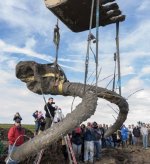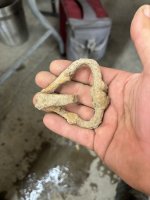Upvote
0
You are using an out of date browser. It may not display this or other websites correctly.
You should upgrade or use an alternative browser.
You should upgrade or use an alternative browser.
Instagram mammoth pic archaeology mag.
- Thread starter Fred250
- Start date
MAMucker
Bronze Member
Cut an artery and run like hell.
The Grim Reaper
Gold Member
This is the one they broke into several pieces because they didn't wrap it before bringing it up. The guy running the backhoe jerked it really hard right before setting it on the flatbed and it broke in a few places.
Aurora1959
Jr. Member
Sever the achilles tendon, which will immediately render it immobile due to its size and weight, and wait for it to die of dehydration. Elephants, and presumably mammoth and mastodon, can't walk with only 3 legs.
joshuaream
Silver Member
I think most modern hunters put a premium on a quick and efficient kill (and not wasting anything.) I don't think ancient hunters could always afford that luxury, or that they needed to.
I imagine a lot of times they would sink a couple of dart points in the lung area, and then just hang back and wait. If the animals were near water or a marsh, the animal probably just stayed there and died hours or days later. Modern elephants will stick around an injured animal, so if mammoths/mastodons/gomphothere were similar to them in that social behavior, that might explain a couple of the multiple animal kill sites. (Get one, see of others stay, dart them, and wait for them to die.)
Big bison jumps out west probably operated similarly, maim a bunch of animals and then butcher them. If the animal is still alive, you've got a bit more time to butcher other animals.
I imagine a lot of times they would sink a couple of dart points in the lung area, and then just hang back and wait. If the animals were near water or a marsh, the animal probably just stayed there and died hours or days later. Modern elephants will stick around an injured animal, so if mammoths/mastodons/gomphothere were similar to them in that social behavior, that might explain a couple of the multiple animal kill sites. (Get one, see of others stay, dart them, and wait for them to die.)
Big bison jumps out west probably operated similarly, maim a bunch of animals and then butcher them. If the animal is still alive, you've got a bit more time to butcher other animals.
Users who are viewing this thread
Total: 2 (members: 0, guests: 2)





